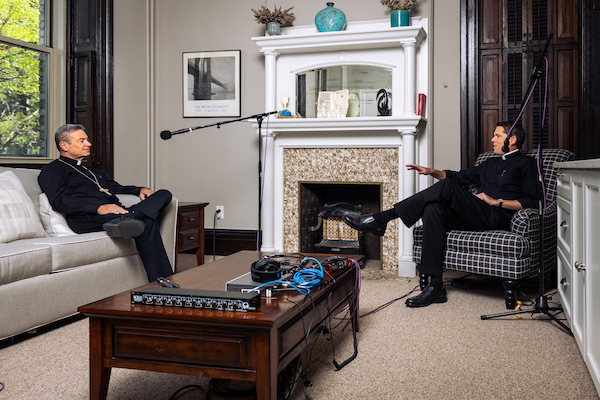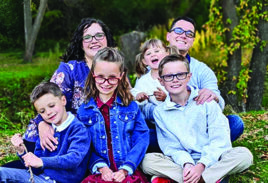
PROSPECT HEIGHTS — Matthew Chicoine joined Instagram eight years ago in response to a tragedy. The death of an unborn child, compounded with the demands of his job as a Catholic school teacher, compelled him to turn to writing on his website (www.thesimplecatholic.blog) and Instagram (@thesimplecatholic) to “grapple with the stress and grief” of that year.
Now, the South Dakota resident has nearly 55,000 Instagram, and is combining his faith, writing ability, and sense of humor to teach and connect with Catholics worldwide.
“My goal is to draw people to the faith that believe all of our essential doctrines and that want to foster the joy of Catholicism in their life and to live it out,” said Chicoine, 36.
With more than 308 million users in the United States, social media allows content creators to share messages with a wider audience than traditional methods. Chicoine is among thousands of Catholic “influencers” — people who promote services or ideologies to a wide audience to impact their thoughts — who are using this tool to evangelize and educate their followers on the faith.
Regardless of the social media platform, Catholic content creators are accessible to people of all ages. For one, the recent growth of people listening to podcasts has made it a popular platform for influencers and content creators.
Here in the diocese, Bishop Robert Brennan turns to the microphone to provide an intimate, 30-minute podcast every week, utilizing that media platform to reach Catholics across New York City. “Big City Catholics,” an evangelization tool begun on Oct. 6, 2022, educates listeners as it explores questions of faith.
“This is sort of the fireside chat that [gives] Bishop Brennan the chance to sit and to delve into topics of great importance,” Father Christopher Heanue, co-host of the podcast, told The Tablet.
Together, Bishop Brennan and Father Heanue, who is the rector of the Co-Cathedral of St. Joseph, have produced over 70 episodes of “Big City Catholics,” and show no signs of stopping anytime soon. Throughout history, the means by which the word of God is shared has constantly changed, and there has been an evolution in the ways clergy can connect with the faithful.
“Big City Catholics” can be found on most streaming services, including Apple Podcasts and Spotify, as well as on Youtube and at podcast.dioceseofbrooklyn.org.
Turning to the same welcoming tool, The Catholic Gentleman, founded in 2013 to offer a community for Catholic men, has drawn hundreds of thousands to visit the website each week.
In podcasts, which they upload weekly to their various social media and streaming platforms. They have a following of 149,000 on Facebook.
On Facebook, Bishop Robert Barron of the Diocese of Winona-Rochester in Minnesota is connecting with 3 million people as the founder of Word on Fire Catholic Ministries — he even has his own merchandise. Recently, the Word on Fire Ministries launched a podcast on their YouTube channel, on which different theological thinkers are invited to a conversation with Tod Worner, managing editor of evangelization & culture for the journal of the Word on Fire Institute.

As its website states: “Word on Fire is evangelical; it proclaims Jesus Christ as the source of conversion and new life. Word on Fire is Catholic; it utilizes the tremendous resources of the Roman Catholic tradition… to explain and interpret the event of Jesus Christ.”
Research by Statistica shows that approximately 50% of the U.S. digital population uses TikTok, a majority of whom are under the age of 30.
On that video-share platform, Emily Cherie (@catholic.converts), 20, shares with 64,000 followers her decision to convert to Catholicism after growing up attending nondenominational churches. Her message includes discussing her own testimony, offering tips on becoming Catholic and ”debunking non-Catholics.”
The Power of Social Media to Educate and Evangelize
As social media use continues to grow among teenagers, it offers a way for the upcoming generation of Church leaders to be evangelized.
This opportunity to educate is what motivated Chicoine, who has a master’s degree in theology, to continue writing. He stepped down from his teaching position in 2015 and now works as a ghostwriter for Catholic businesses, but he wanted to sustain his instructing talents while keeping young Catholics entertained and engaged.

On his Instagram feed, most of what Chicoine posts are lighthearted images intended to educate followers, while at the same time reminding them of the joys of the Catholic faith. He will share stories about his children’s antics during Mass, along with an overall Catholic message.
But not all of Chicoine’s posts are humorous. Last month, he reflected on the Transfiguration of Jesus, and how the Holy Spirit can spark a transfiguration of one’s own life. He and his wife Jessica have four children, two of whom have autism. By engaging in social media conversations about ADHD and children with autism, he feels he is relating to people in similar situations.
To Katherine Bogner, teaching is a part of who she is. She became a public school teacher at age 23, and now, at 38, teaches sixth through eighth grade for the Diocese of Peoria, Illinois.

Using social media to evangelize came naturally; 13 years ago she launched a website to offer resources to those in her local parish who may not have the time or ability to discover them on their own.
Bogner learned that there are people who may have the desire to share the faith with their children, but sometimes don’t know exactly how. That is where she stepped in. On her Instagram (@katherine.bogner) and website (www.looktohimandberadiant.com), she displays the educational billboards she creates for her classroom, celebrates feast days, and directs followers to resources to enhance their faith and that of their families. Her Instagram following has grown to 14,000.
While it can be vulnerable to share one’s personal life on social media, Bogner said it has allowed her to have a more intimate connection with her audience. Showing there is a person behind the posts, she says, encourages people to listen to her message, which is to remind people that they are loved by God.
“I think it is important that through a tool like social media, even though it is not technically face- to-face, we still can share the faith of Christ through this new tool,” Bogner said.
